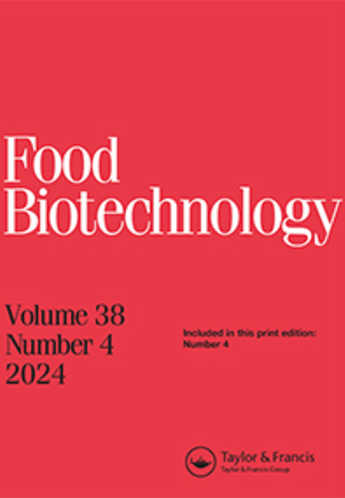Diversity Analysis of Culturable Epiphytic Microbial Consortia of Table Grape Berry Surface
IF 1.6
4区 农林科学
Q4 BIOTECHNOLOGY & APPLIED MICROBIOLOGY
引用次数: 0
Abstract
ABSTRACT The health and yield of grapes are affected by the microorganisms associated with the grapevine. The diversity of microorganisms present on the wine grape varieties is well defined whereas, the information associated with the microorganisms of table grape varieties remains scarce. In the present study, culture-dependent method was used to isolate the microbes present on the surface of the commercial white seedless table grape cultivar, Thompson Seedless at different stages of berry development. The microbial load of the grape berry surface increased as the berry progressed toward the ripening stage resulting in the identification of core bacteria (29), filamentous fungi (19) and yeast (3). A diversity analysis study also revealed that Cladosporium cladosporioides, was found in the vineyard on grapes from the early berry development stages, as an emerging pre-harvest pathogen. The study would help in understanding and exploiting the microbiota of table grape berry in agronomic and biotechnological applications.葡萄表面可培养附生微生物群落多样性分析
葡萄的健康和产量受到葡萄藤上微生物的影响。葡萄酒葡萄品种上存在的微生物的多样性是明确的,而与食用葡萄品种的微生物相关的信息仍然很少。在本研究中,采用培养依赖性方法分离了商业白无核食用葡萄品种汤普森无核葡萄在浆果发育的不同阶段表面的微生物。葡萄浆果表面的微生物负荷随着浆果走向成熟阶段而增加,从而鉴定出核心细菌(29)、丝状真菌(19)和酵母(3)。一项多样性分析研究还表明,在葡萄园中,从浆果发育的早期阶段就发现了枝孢霉,作为一种新出现的收获前病原体。这项研究将有助于了解和利用食用葡萄浆果的微生物群在农艺和生物技术应用中的作用。
本文章由计算机程序翻译,如有差异,请以英文原文为准。
求助全文
约1分钟内获得全文
求助全文
来源期刊

Food Biotechnology
工程技术-生物工程与应用微生物
CiteScore
3.80
自引率
0.00%
发文量
15
审稿时长
>12 weeks
期刊介绍:
Food Biotechnology is an international, peer-reviewed journal that is focused on current and emerging developments and applications of modern genetics, enzymatic, metabolic and systems-based biochemical processes in food and food-related biological systems. The goal is to help produce and improve foods, food ingredients, and functional foods at the processing stage and beyond agricultural production.
Other areas of strong interest are microbial and fermentation-based metabolic processing to improve foods, food microbiomes for health, metabolic basis for food ingredients with health benefits, molecular and metabolic approaches to functional foods, and biochemical processes for food waste remediation. In addition, articles addressing the topics of modern molecular, metabolic and biochemical approaches to improving food safety and quality are also published.
Researchers in agriculture, food science and nutrition, including food and biotechnology consultants around the world will benefit from the research published in Food Biotechnology. The published research and reviews can be utilized to further educational and research programs and may also be applied to food quality and value added processing challenges, which are continuously evolving and expanding based upon the peer reviewed research conducted and published in the journal.
 求助内容:
求助内容: 应助结果提醒方式:
应助结果提醒方式:


